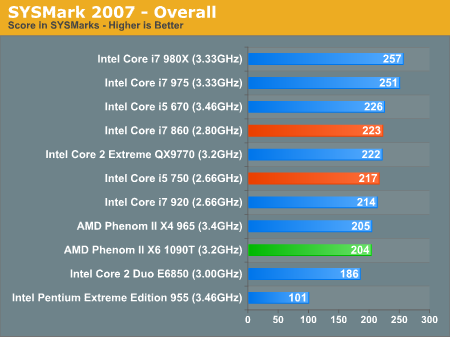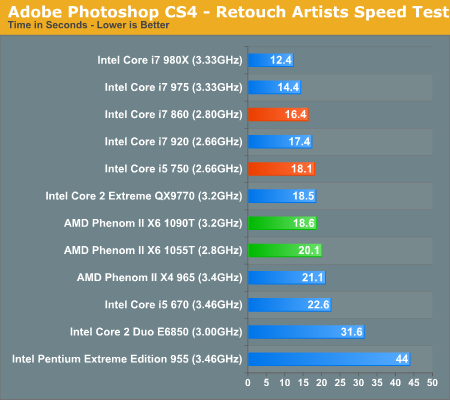AMD's Six-Core Phenom II X6 1090T & 1055T Reviewed
by Anand Lal Shimpi on April 27, 2010 12:26 AM EST- Posted in
- CPUs
- AMD
- Phenom II X6
SYSMark 2007 Performance
Our journey starts with SYSMark 2007, the only all-encompassing performance suite in our review today. The idea here is simple: one benchmark to indicate the overall performance of your machine.
SYSMark really taxes two cores most of the time, giving the edge to Lynnfield and its aggressive turbo modes. Lightly threaded or mixed workloads won't do so well on the Phenom II X6.

Adobe Photoshop CS4 Performance
To measure performance under Photoshop CS4 we turn to the Retouch Artists’ Speed Test. The test does basic photo editing; there are a couple of color space conversions, many layer creations, color curve adjustment, image and canvas size adjustment, unsharp mask, and finally a gaussian blur performed on the entire image.
The whole process is timed and thanks to the use of Intel's X25-M SSD as our test bed hard drive, performance is far more predictable than back when we used to test on mechanical disks.
Time is reported in seconds and the lower numbers mean better performance. The test is multithreaded and can hit all four cores in a quad-core machine.

Performance here is good, but even Photoshop doesn't make consistent enough use of all six cores to really give the Phenom II X6 the edge it needs here. It's faster than the Phenom II X4, but not faster than the Core i5 750.










168 Comments
View All Comments
JGabriel - Tuesday, April 27, 2010 - link
I agree with your approach, Anand. As a customer, and for a general review, I'm most interested in what performance I can get without increasing the core voltage and power consumption.Pushing the overclock seems more suited for a separate article, or for sites specializing in overclocking or gaming.
.
GullLars - Tuesday, April 27, 2010 - link
+1 on more overclocking testing. It could be a new article dedicated to investigating OC vs stock against the i5 cpus. Also, i remember seing some results for powerconsumption pr performance on different clocks and voltages, that would be interresting to see for the PII x6.I would also like to see what effect just bumping the FSB up from 200 makes, and how high you get it with stable turbo modes. Finding the max stable FSB with lowered multiplier gives a hint to how far it can clock, and how far the non-BE versions can clock.
I'm considering a a 1090T BE or 1055T to replace my 9850BE (too hot, and won't OC) untill bulldozer chips come out. If the 1055T can take a 20-25% FSB increase and stay stable, that would be my choice.
Anand Lal Shimpi - Tuesday, April 27, 2010 - link
Ask and you shall receive: http://anandtech.com/show/3676/phenom-ii-x6-4ghz-a...jav6454 - Tuesday, April 27, 2010 - link
I miss when Intel was on the run for the market... AMD's 6-core does well, but it'd marginally better than a 4-core from Intel... true you get more cores, but is them small performance worth it? I think not.KaarlisK - Tuesday, April 27, 2010 - link
Overclocking it is definitely interesting, and it would be nice to know whether it's power consumption is much lower or not. It's a lower bin, so it should have slightly higher power consumption at the same clock, but it does have a much lower clock.Anand Lal Shimpi - Tuesday, April 27, 2010 - link
We didn't have an actual Phenom II 1055T, we simply underclocked our 1090T and lowered the turbo core ratios to simulate one. This is why we don't have power consumption results for it either.Take care,
Anand
adrien - Tuesday, April 27, 2010 - link
Hi,I find the results of the 7zip compression benchmark a bit weird. I own a Phenom II X4 955 and I'm currently compressing something (800MB) in a windows7 virtual machine with only two cores (way to go MS!). Still, I'm getting something more than 2MB/s (and this virtual machine has crappy disk I/O, maybe less than 4MB/s sustained). LZMA is slower on data that compresses badly so it's not possible to draw conclusions but overall, it still looks weird.
Which version of 7zip is being used? 4 or 9? And which minor version?
Also, are you using LZMA or LZMA2? IIRC, LZMA can only use 2 threads while LZMA2 can use more (maybe powers of two, not sure).
Also, I think that the 64bit versions are faster. I guess you're using 64bit binaries but it's better to check (running 32bit software on 64bit OSes indeed has a cost), maybe like 5% to 15%.
Anand Lal Shimpi - Tuesday, April 27, 2010 - link
I'm using 7-zip 9.10 beta and LMZA compression in order to compare to previous results, which unfortunately limits us to two threads. In the future we'll start transitioning to LMZA2 to take advantage of the 4+ core CPUs on the market. Today I offer both the benchmark results (max threads) and the compression test (2 threads) to give users an idea of the spectrum of performance.Take care,
Anand
adrien - Wednesday, April 28, 2010 - link
OK, very good. Thanks. :-)That explains why the deca (and actually quad) cores don't benefit much from that. It'd probably deserve a mention on the chart or next to it.
adrien - Wednesday, April 28, 2010 - link
Not decacores but hexacores of course. Too early in the morning I guess.